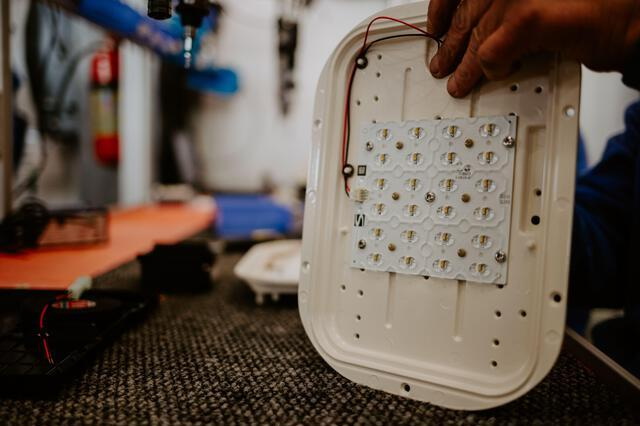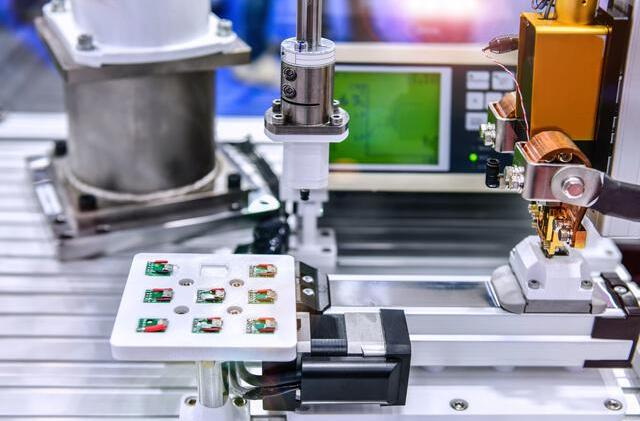Content Menu
● Understanding SMT PCB Training
● Core Skills Gained From SMT PCB Training
>> 1. Fundamentals of PCB Assembly
>> 2. Soldering Techniques
>> 3. Component Identification and Handling
>> 4. Assembly Process Knowledge
>> 5. Defect Recognition and Troubleshooting
>> 6. Quality Assurance and Industry Standards
>> 7. Use of SMT Assembly Equipment
>> 8. Safety and Environmental Considerations
● Additional Benefits of SMT PCB Training
>> Hands-on Practical Experience
>> Certification and Career Advancement
>> Problem-Solving and Analytical Skills
>> Staying Current with Industry Trends
● Conclusion
● FAQ
>> 1. What is the duration of a typical SMT PCB training course?
>> 2. Do SMT PCB training courses include hands-on practice?
>> 3. What certifications can I earn from SMT PCB training?
>> 4. Is prior experience required to enroll in an SMT PCB training course?
>> 5. How does SMT PCB training improve job prospects?
Surface Mount Technology (SMT) has revolutionized the electronics manufacturing industry, particularly in the assembly of printed circuit boards (PCBs). As electronic devices become smaller, faster, and more complex, the demand for skilled professionals who understand SMT PCB assembly processes continues to grow. An SMT PCB training course is an essential stepping stone for anyone looking to enter or advance in this dynamic field. This article explores in detail the wide range of skills you will acquire from an SMT PCB training course and how these competencies can boost your career.

Understanding SMT PCB Training
SMT PCB training courses are specialized programs designed to teach the theory and practical skills involved in surface mount technology for PCB assembly. These courses typically cover everything from the basics of PCB design and materials to advanced soldering techniques and quality control procedures. The training often includes a blend of classroom instruction, video demonstrations, and hands-on workshops, ensuring participants gain both knowledge and real-world experience.
The goal of SMT PCB training is to produce technicians and engineers who can efficiently assemble, inspect, and troubleshoot SMT PCBs while adhering to industry standards and safety protocols. Whether you are a beginner or an experienced professional, these courses help you stay current with evolving technologies and best practices.
Core Skills Gained From SMT PCB Training
1. Fundamentals of PCB Assembly
A solid foundation in PCB assembly is critical to understanding SMT processes. In an SMT PCB training course, you will learn about:
- PCB Types and Materials: Different types of PCBs (single-sided, double-sided, multilayer) and the materials used, such as FR4, ceramic, and flexible substrates.
- Surface Finish Options: Various finishes like HASL (Hot Air Solder Leveling), ENIG (Electroless Nickel Immersion Gold), and OSP (Organic Solderability Preservative) that affect solderability and reliability.
- SMT vs. Through-Hole Technology: The course explains the fundamental differences, advantages, and limitations of SMT compared to traditional through-hole assembly, helping you understand why SMT is preferred for modern electronics.
2. Soldering Techniques
Soldering is at the heart of SMT PCB assembly. Training covers:
- Solder Paste Application: Learn how to use stencils and squeegees to apply solder paste precisely onto PCB pads. Accurate paste application is crucial for creating strong solder joints.
- Reflow Soldering: Understand the reflow soldering process, including oven profiling to ensure the solder paste melts and solidifies correctly without damaging components.
- Hand Soldering and Rework: Develop fine motor skills for manually soldering small SMT components and performing rework tasks such as removing defective parts and replacing them with new ones. This includes learning to use soldering irons, hot air rework stations, and solder wick.
3. Component Identification and Handling
Proper handling and identification of SMT components are essential skills taught in the training:
- Component Types: Recognize a wide variety of SMT components, including passive components (resistors, capacitors, inductors), active components (ICs, transistors, diodes), and complex packages such as BGAs (Ball Grid Arrays) and QFNs (Quad Flat No-leads).
- Component Markings: Learn how to read component codes, polarity markings, and packaging information.
- Handling and Storage: Training emphasizes Electrostatic Discharge (ESD) precautions, moisture sensitivity levels (MSL), and proper storage methods to avoid component damage and ensure assembly quality.
4. Assembly Process Knowledge
Understanding the entire SMT assembly workflow is a critical outcome of the training:
- Printing: Master the solder paste printing process, including stencil alignment and cleaning.
- Placement: Learn how automated pick-and-place machines work, including feeder setup, component orientation, and placement accuracy.
- Inspection: Gain skills in manual visual inspection and automated optical inspection (AOI) to detect defects early in the assembly process.
- Reflow and Cooling: Understand the importance of controlled heating and cooling cycles in reflow ovens to prevent solder joint defects.
5. Defect Recognition and Troubleshooting
An essential part of SMT PCB training is learning to identify and correct common assembly defects:
- Common Defects: Solder bridging, tombstoning (where one end of a component lifts off the pad), insufficient solder, solder balls, and component misalignment.
- Root Cause Analysis: Understand the causes behind these defects, such as incorrect stencil thickness, poor solder paste quality, or improper reflow profiles.
- Corrective Actions: Learn how to adjust processes, equipment settings, or materials to minimize defects and improve yield.
6. Quality Assurance and Industry Standards
Quality is paramount in electronics manufacturing. SMT PCB training courses cover:
- IPC Standards: Become familiar with IPC-A-610 (Acceptability of Electronic Assemblies), IPC-J-STD-001 (Requirements for Soldered Electrical and Electronic Assemblies), and IPC-7711/7721 (Rework, Modification, and Repair).
- Inspection and Testing: Learn various testing methods, including In-Circuit Testing (ICT), Flying Probe Testing, and Functional Testing, to verify the integrity and functionality of assembled PCBs.
- Documentation and Traceability: Understand the importance of maintaining process documentation and traceability to meet customer and regulatory requirements.
7. Use of SMT Assembly Equipment
Hands-on experience with SMT equipment is a major component of training:
- Stencil Printers: Learn how to set up and operate stencil printing machines, including stencil alignment and squeegee pressure adjustments.
- Pick-and-Place Machines: Gain insights into programming and operating placement machines, including feeder loading, nozzle selection, and troubleshooting placement errors.
- Reflow Ovens: Understand oven setup, temperature profiling, and atmosphere control (e.g., nitrogen use) to optimize soldering quality.
- Inspection Tools: Use magnification tools, microscopes, and AOI systems to perform detailed inspections.
8. Safety and Environmental Considerations
SMT PCB training also emphasizes safety and environmental responsibility:
- Workplace Safety: Learn safe handling of chemicals (flux, solder paste), proper ventilation, and personal protective equipment (PPE) usage.
- ESD Safety: Understand ESD control methods, including grounding, wrist straps, and ESD-safe workstations.
- Environmental Compliance: Gain knowledge of RoHS (Restriction of Hazardous Substances) and other environmental regulations affecting materials and processes.

Additional Benefits of SMT PCB Training
Hands-on Practical Experience
One of the most valuable aspects of SMT PCB training is the opportunity to practice real-world assembly tasks. This hands-on experience builds confidence and helps you develop the dexterity and precision required for high-quality SMT assembly.
Certification and Career Advancement
Completing an SMT PCB training course often results in industry-recognized certifications that validate your skills. These certifications can open doors to better job opportunities, promotions, and higher salaries in electronics manufacturing.
Problem-Solving and Analytical Skills
Training encourages critical thinking and problem-solving, enabling you to analyze assembly issues, optimize processes, and contribute to continuous improvement initiatives in your workplace.
Staying Current with Industry Trends
SMT PCB training courses are regularly updated to reflect the latest technologies, equipment, and standards, ensuring you remain competitive in a rapidly evolving industry.
Conclusion
An SMT PCB training course equips you with a comprehensive set of skills essential for modern electronics manufacturing. From mastering soldering techniques and component handling to understanding assembly workflows and quality standards, the training prepares you to meet the challenges of SMT PCB assembly with confidence and expertise. Whether you are starting your career or seeking to enhance your existing skills, investing in SMT PCB training is a strategic step toward professional growth and success in the electronics industry.

FAQ
1. What is the duration of a typical SMT PCB training course?
Most SMT PCB training courses last between 2 to 3 days for intensive boot camps, while some online or extended courses may span several weeks depending on depth and format.
2. Do SMT PCB training courses include hands-on practice?
Yes, practical hands-on sessions are a key component, allowing students to work directly with soldering, rework, placement machines, and inspection equipment to gain real-world experience.
3. What certifications can I earn from SMT PCB training?
Participants can earn certifications such as IPC-A-610, IPC-J-STD-001, and other IPC-related credentials, which are widely recognized in the electronics manufacturing industry.
4. Is prior experience required to enroll in an SMT PCB training course?
Many courses cater to beginners with no prior experience, providing foundational knowledge. However, advanced courses may require some background in electronics assembly.
5. How does SMT PCB training improve job prospects?
The training equips you with industry-standard skills, hands-on experience, and certifications that employers value, significantly enhancing your employability in electronics manufacturing and assembly roles.




















